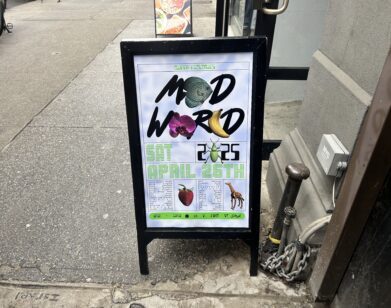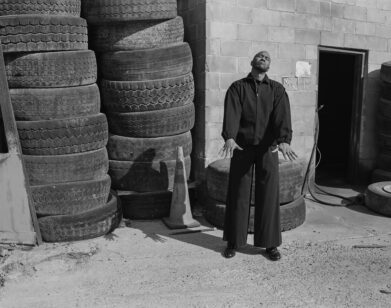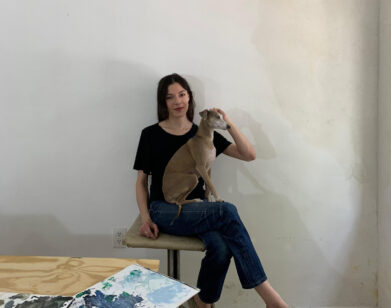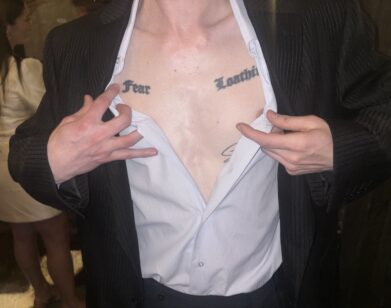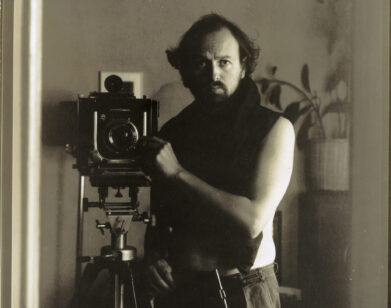Exclusive: Why Scott Campbell Lit His Art on Fire
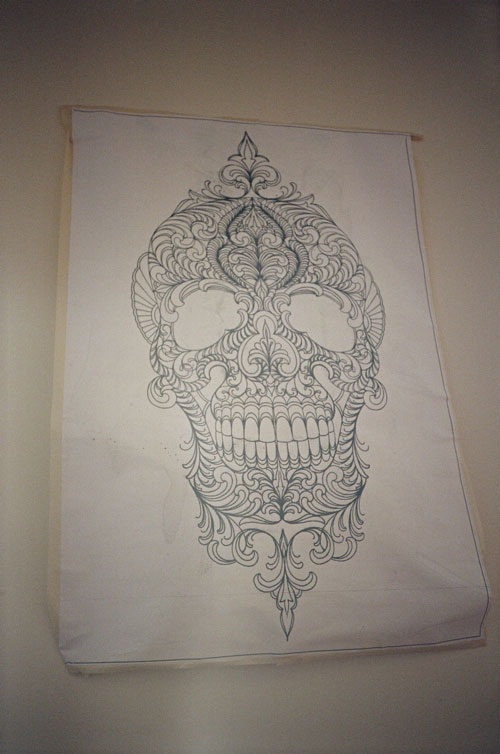
SCOTT CAMPBELL. PHOTOS BY JACK SIEGEL
An e-mail recently surfaced on Purple Diary’s Tumblr that was sent from New York-based artist Scott Campbell to Purple Magazine’s founder, Olivier Zahm. The e-mail simply read that Scott had some problems with his concerns being taken seriously by the gallery owner at his recent sold-out show at Mexico City’s Vice Gallery (an edition of the Canadian magazine of the same name)—so he pulled his work on the sidewalk in front of the gallery and lit it on fire. The post revealed something about Campbell’s state of mind—”It felt amazing,” Campbell wrote—but raised a lot of questions.
We caught up with Scott at his Brooklyn home, where he explained to us exactly what went down.
KRISTINA BENNS: How did you first get involved with working in Mexico?
SCOTT CAMPBELL: I was in Mexico City doing a documenting project, going into a big prison down there, Santa Marta prison. I really just wanted to document what they were getting tattooed. I got really close with some of the prisoners and spent two weeks in the prison, making crazy Frankenstein tattoo machines out of electric razors and guitar strings and toothbrushes, and tattooing a lot of these guys on the inside with them.
When I went to Mexico City last week, I went back to the prison to follow with the prisoners. It’s crazy how fast shit changes. Of the three people I worked with, one had killed a guy. He was supposed to get out at the end of the year. I went back, like, “Where’s Luis?” and they said, “Oh, he stabbed some guy and got another five years tacked on…” Only one of the guys I worked with before was still in the same place.
Life has much less value down there than it does in other places.
BENNS: Who set up your recent show in Mexico?
CAMPBELL: When I was down there, I met this guy, the publisher of VICE Mexico, and he had e-mailed me about doing a show down there. And I said, “Sure, I love Mexico City.” It’s not known for its pool of collectors or anything, but I love Mexico culturally. There’s a feeling of lawlessness. It retains a bit of the Wild West.
BENNS: So… Where did it start to go wrong?
CAMPBELL: [LAUGHS] You mean, what the hell happened?
I didn’t do it out of spite. A lot of the complications were because I was in New York and didn’t go down until the day before the show. I was nervous about doing a show with [Vice Mexico]; they’re a young gallery. But I liked the sound of their program. They import reputable artists, but they have a project room that always supports local artists. I thought that was a nice gesture.
BENNS: What were your concerns before going down?
CAMPBELL: One of the main things was, they were going to get a sponsor for the show. I was really clear about my hesitance about having a corporate sponsor for an art show. They said it would be a little logo at the bottom of the invitation, tastefully done, they explained it as the way things worked in Mexico. I said, “OK, I’ll trust you on this one, and take your word for it, just know I’m very cautious about this.”
BENNS: Art and advertising have very strict boundaries at the level of the commercial gallery.
CAMPBELL: I got there and it was like, a full-on vodka commercial. Banners everywhere. On the invitation, the name of the company was at the top, printed larger than my name and the name of the show.
I bit my tongue. I was really happy with everything we made for the show, and proud to show it [in Mexico]. Everybody showed up for the show and was very positive about it. The show sold out; they had never had a sold-out show before. I think their heart’s in the right place, but I think when they started seeing dollar signs, I think when they started doing the accounting, they got a little bit ahead of themselves. The main guy I was dealing with started to get a little bit too pushy. All of a sudden took the position that I owed them.
He kept bringing up, repeatedly, the dollar amount of the show. He kept talking about how they had made me money. But I could have made this work, and sold it out of my studio to my collectors, without giving them a cut, and saved myself the trip. I was there because I love Mexico City. I sent him an e-mail saying I wanted to keep things cool, and I thought he was being a little pushy and for us to just ride out the rest of the show.
Essentially, I had some issues, and when I confronted him with these issues in what I felt was a productive way, he came back with a personal attack. Really childish name-calling. I can’t work with that. If we’re all focused on a common goal, then we’re communicating, but as soon as somebody takes it to a competition of egos… I’m not going to entertain that.
BENNS: So it was the insults?
CAMPBELL: I decided I was done. If he’s going to wave this dollar amount in front of my face, then fine: No one makes any money.
There was a gas station across the street from the gallery, conveniently. I filled up a gallon and set the gallon of gasoline at the front door. I had a couple friends of mine there to help carry stuff out, and I said, “OK, I’m going to go upstairs, we’re going to have a conversation, and if it goes well, we’re all good. If the conversation doesn’t go well, then I need your help getting all of this stuff out of the gallery.” I went upstairs and told him, “You sent me this e-mail, and I need you to explain it to me in a way that I am going to be okay with it.” But it was the same pissing contest. So I was done. We started taking everything off the walls, walked it outside, poured a bunch of gasoline on it, and lit it on fire.
BENNS: Was he more receptive after that?
CAMPBELL: It’s amazing how people will just snap to attention. I’m sitting there in front of this burning pile of money, literally and figuratively, and he’s like, “Let’s talk! Let’s talk! Let’s talk!” I was like, “Dude, talk fast, whatever you’ve got to say, you better say it real quick.”
His partner in the gallery came out and she’s super nice, she’s great. I calmed down a little bit, and I told her, “I’m walking away now. Call me later, we’ll have dinner.” I guess they got a fire extinguisher, and put everything out, and got it back in the gallery. I met with the guy’s partner. I don’t like burning bridges, or bad blood. I got scared. I’m very protective of my work, it means a lot to me, and to think of leaving Mexico City with my work, reputation, and name, in the hands of someone I don’t trust, I couldn’t do that. I couldn’t just abandon it there.
BENNS: What were your concerns about this gesture, beyond the gallerists?
CAMPBELL: It wasn’t some dramatic tantrum of a bratty art star. I sat there for a day and a half trying to figure out that situation. I really felt trapped and held hostage, so I thought, “I’ll destroy it. I’ll just come home and make more.” I’d rather just pull out completely than have myself be misrepresented.
BENNS: Did you reconcile with the gallery?
CAMPBELL: We have a very delicate truce at the moment. They have a huge obligation to their collectors, obviously. They took money for all this stuff and sold it. We left it; they can keep the works through the end of the show as scheduled. But, they’re all burnt and they have to display them as they are, with an honest explanation about what happened, and why they are in that condition. And at the end of the show, if everything’s kosher, they return all the burned works to me and I’ll replace them with new pieces.
BENNS: [LAUGHS] Which seems… fair?
CAMPBELL: I can’t just sweep it under the rug and say it’s all good, because that’s not the case. I did confront myself on it a few times, about whether I’m being selfish. But now any other artist this gallery works with, from here on out, will have a stronger voice, and will be given more respect. That’s a good cause.
BENNS: And maybe, as a young gallery, there’s something to be said for being held accountable.
CAMPBELL: Absolutely. This is the first press I’ve done regarding this situation, and I really want to be fair. I just want to be honest about what happened, and assume they’ll do the same. It’s funny, me lighting this show on fire, in a way it was sort of a fuck-you, but it’s the most attention the gallery has ever gotten. It’s a catch-22.
BENNS: Did this incident tap into any general frustration with the art world?
CAMPBELL: Well, selling art is an age-old job. As soon as you commodify art, or put value on it, it’s hard not to be corrupted. There’s always that issue of an artist making a living and keeping themselves fed, while producing work that’s not swayed by the market of the audience. You can’t think about your work in terms of money, because it gets harder and harder to stay spontaneous. You have to be able to burn it all down at any moment, in order to keep it fresh and new. You can’t hang onto it too much.

